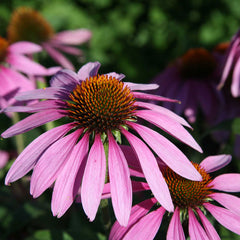

Echinacea Leaf (Echinacea purpurea)
- $14.00 CAD
- $14.00 CAD
- Unit price
- per
50g, 100g, 250g
Couldn't load pickup availability
Parts used: Root, flowers and leaves
Properties
Adaptogen, alterative, antibiotic, neoplastic, antiseptic, antiviral, blood purifier, carminative, demulcent, digestive, sialagogue, stimulant, vulnerary
Primary nutrients
Calcium, iodine, iron, potassium, sulfur, vitamins A, C and E
Echinacea is used for many different ailments. It is used as a blood purifier against strep and staph infections. It is known to fight chemical toxic poisoning in the body. It has been used as a treatment for candida yeast infections and also has the ability to kill fungus. It is beneficial for blood poisoning, ulcers, tuberculosis, pyorrhea, childhood diseases, spinal meningitis and gangrene. Echinacea is probably the best-known herbal immune booster. It has been found to help with many immune functions.
Echinacea is known to stabilize the white blood cell count in the body. It contains antiviral properties that are known to increase the activity of the leukocytes (white blood cells), allowing them to do their job of fighting and destroying toxic organisms that invade the body. It contains antiseptic properties, helping cleanse and reduce pain with external and internal injuries.
One of the greatest benefits of Echinacea may be its ability to help prevent and shorten the duration of the common cold and flu.
Another favourable use for Echinacea may be in the treatment of some forms of cancer and tumors. Along with its ability to improve immune functions, Echinacea may help stimulate macrophages to fight tumor cells. Cancer patients undergoing radiation treatments generally suffer from a reduced white blood cell count. Echinacea may help to increase the white blood cells for these individuals.
Primary Applications
Acne
Blood impurities
Boils
Ear infection
Glandular problems
Immune system, weak
Infection
Lymphatic problems
Mouth sores
Mucus, excessive
Peritonitis
Poisoning, blood
Prostate problems
Skin disorders
Wounds
Secondary Applications
Bites
Bronchitis
Cancer
Diphtheria
Eczema
Fevers
Flu
Gangrene
Gastric disorders
Gingivitis
Hemorrhages
Laryngitis
Pyorrhea
Strep throat
Throat, sore
Tonsillitis
50g, 100g, 250g
RELATED PRODUCTS
- Choosing a selection results in a full page refresh.



